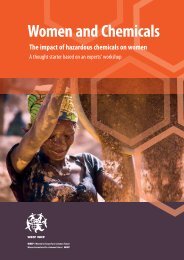future now”
YAO19
YAO19
Create successful ePaper yourself
Turn your PDF publications into a flip-book with our unique Google optimized e-Paper software.
A Syrian woman in the Zabadani<br />
neighbourhood in Damascus talks to<br />
the head of the UN observers team (2012).<br />
Photo: TT/AP Photo/Muzaffar Salman<br />
activists organized demonstrations demanding the release<br />
of their children who were seized by the armed<br />
group, Jayesh al-Islam, while the men avoided criticizing<br />
the group’s behavior for fear of further repression and<br />
arrest. Such increased difficulties do not appear to be as<br />
prominent in the Kurdish autonomous areas in northern<br />
Syria.<br />
Some of the women activists pointed to the ruling autonomous<br />
administration’s commitment to the involvement<br />
of women in negotiation delegations and decision-making<br />
positions through the so-called mutual administration 12<br />
and a woman participation quota in all political and<br />
negotiation delegations. Other activists highlighted that<br />
the lower amount of violence present in their regions<br />
allowed for more women’s agency, for example in their<br />
participation in local negotiations.<br />
27<br />
Other activities carried out by the individual women<br />
activists were mediation efforts to release detainees<br />
kidnapped by various armed factions. Many of the activists<br />
said this role was facilitated by the stereotypical image of<br />
women as being peaceful and not having any political or<br />
military missions. Instead, the counterpart viewed their<br />
mediation simply as a woman aiming to achieve emotional<br />
and humanitarian gains in terms of reuniting other<br />
women with their children, family members or acquaintances.<br />
Regardless of the negative impact of such gender<br />
stereotyping, which the activists themselves were aware<br />
of, in many cases, the women’s efforts had been fruitful in<br />
accomplishing the release of the detainees.<br />
Another important involvement of individual women<br />
activists was found in efforts to prevent potential violence.<br />
One example is revenge-deterring mechanisms<br />
organized by individual women activists and groups alike,<br />
for example, the previously mentioned visits to the families<br />
of victims after a violent clash to extend condolences<br />
13 . In many cases, the activists said, their delegations<br />
included women from different groups of society, including<br />
the group that could be blamed for the death at<br />
hand. For example, a man from Sakba, a Damascus suburb,<br />
was killed by the Popular Committees 14 in Jaramana,<br />
another suburb, and tension grew between the two areas.<br />
A woman activist responded by organizing a reconciliation<br />
initiative with the participation of other women<br />
activists and both cities’ elders to extend condolences to<br />
the victim’s family on behalf of the people of Jaramana.<br />
Similar incidents also took place in Kisweh and Zakia, two<br />
other suburbs of Damascus.



